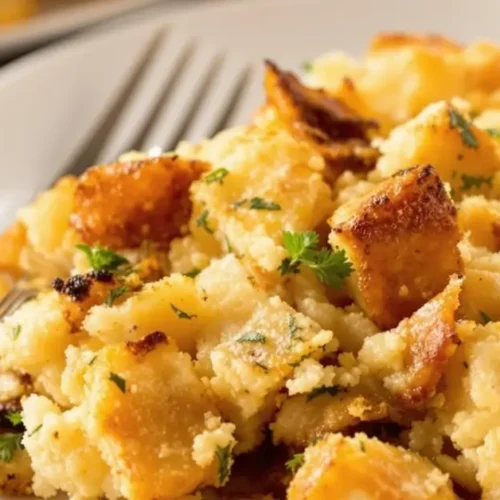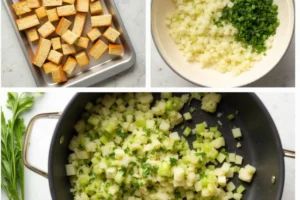As the scent of autumn leaves fills the air and families gather, the heart of Thanksgiving beats stronger. Imagine adding a twist to your traditional feast, something that warms the soul and delights the senses. This Garlic Bread Stuffing recipe isn’t just a dish; it’s a hug in a bowl, a symphony of flavors that evokes memories of laughter and togetherness. Let’s embark on this culinary journey, where each ingredient tells a story of comfort, love, and the joy of sharing a meal that truly nourishes.

QUICK LINKS
What You'll Find in This Guide
What makes the garlic bread stuffing recipe the Best?
What truly sets this garlic bread stuffing apart is its innovative approach to a classic dish, transforming it into an unforgettable Thanksgiving centerpiece. Unlike traditional stuffings that often rely on standard bread cubes, this recipe elevates the texture and flavor profile by using garlic bread as its base. The inherent garlicky, buttery notes of the bread infuse every bite with a rich, savory depth, eliminating the need for excessive seasoning.
This unique foundation, combined with a medley of fresh herbs and vegetables, creates a harmonious blend of flavors that is both comforting and exciting. The result is a stuffing that is incredibly delicious and remarkably easy to prepare, making it the perfect addition to any Thanksgiving table, promising to captivate taste buds and leave guests craving more.
Key Features of Great Staffing
So, what separates a good stuffing from the best stuffing recipe? Here are a few must-have elements:
- Flavor Balance
A great stuffing combines savory, aromatic, and herby flavors seamlessly. The earthy tones of sage and thyme should complement the richness of the butter and broth, with a hint of sweetness from add-ins like dried cranberries or caramelized onions. - Texture Perfection
The texture of the stuffing is everything. It should be moist and tender but not overly wet or mushy. At the same time, the perfectly baked stuffing has a golden, slightly crispy top layer that adds a delightful contrast to the soft interior. - Customizability
One of the best things about stuffing is its versatility. Whether you prefer a classic bread-based version, a gluten-free alternative, or a bold twist with international flavors, stuffing is a dish you can truly make your own.
Creating the best stuffing recipe doesn’t have to be complicated. It’s about finding the right balance of ingredients and techniques that suit your tastes and traditions. Let’s explore those essential elements step by step in the sections ahead.
Ingredients for the garlic bread stuffing recipe
Here’s a quick reference for the essential ingredients:
| Ingredient | Quantity | Notes |
|---|---|---|
| Stale bread cubes | 8 cups | Sourdough or rustic bread |
| Butter | ½ cup | Unsalted for better control of seasoning |
| Celery | 1 cup | Finely chopped |
| Onion | 1 cup | Finely chopped |
| Chicken or turkey broth | 2 cups | Adjust based on bread type |
| Fresh sage and thyme | 1 tbsp each | Or 1 tsp each of dried herbs |
With these ingredients in hand, you’re ready to create rich, flavorful, and unforgettable stuffing. Whether you stick to the essentials or get creative with add-ins, the key is balancing flavors and textures for a dish that everyone will love.
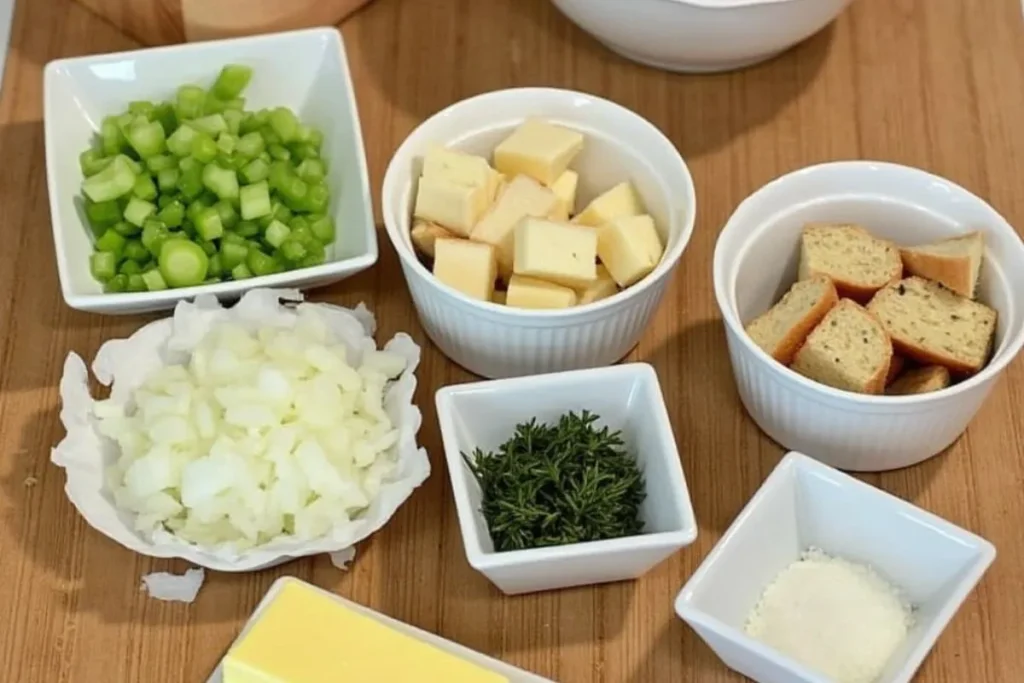
Build-Your-Own Stuffing Recipe
The best stuffing recipe isn’t just about following a basic formula—it’s about making it your own. The beauty of stuffing lies in its versatility, allowing you to tweak ingredients, flavors, and textures to match your personal preferences. Whether you’re sticking to traditions or adding modern twists, there are endless ways to customize your Thanksgiving stuffing. Let’s dive into how you can make this dish truly your own, ensuring it stands out on your holiday table.
Flavor Variations
One of the easiest ways to customize your stuffing is by incorporating different flavor profiles. The beauty of this dish is that it can take on regional, international, or even personal flavor influences. Here’s how you can spice things up:
- Regional Styles: Each part of the U.S. has its take on stuffing. In the South, cornbread stuffing is king, with a slightly sweet and savory flavor. In New England, stuffing might include seafood, offering a delicate, briny bite that’s perfect for a coastal twist.
- International Twists: Want to add something exotic? Try incorporating Italian pancetta or prosciutto for a savory, salty punch. You can also experiment with Indian spices like cumin, coriander, and turmeric to give your stuffing a warm, aromatic flavor that pairs wonderfully with roasted turkey.
Experimenting with different flavors not only makes your stuffing unique but also adds a personal touch that reflects your taste and creativity.
Dietary Modifications
Many Thanksgiving guests come with specific dietary needs, so customizing your stuffing to be more inclusive is a great way to ensure everyone feels included. Here are some popular options:
- Gluten-Free Swaps: Traditional bread-based stuffing may not work for those with gluten sensitivities, but it’s easy to adapt! Simply swap the bread for gluten-free bread or even rice for a completely different texture.
- Vegetarian and Vegan Adaptations: To make your stuffing vegetarian or vegan, skip the sausage or meat-based broth and use vegetable broth instead. You can also add more veggies like mushrooms, sweet potatoes, or butternut squash to give it a hearty substance.
The flexibility in ingredient swaps ensures that your stuffing can cater to various dietary restrictions while still maintaining all the delicious flavors.
Customizing your stuffing doesn’t have to be complicated. Whether you’re adjusting flavors to suit your preferences or accommodating dietary needs, the key is to experiment and have fun. With the right ingredients and a little creativity, you can make a stuffing recipe that will be remembered for years to come!
By purchasing through this link, I may earn a small commission at no extra cost to you, helping to support this site
Stuffing Gone Wrong? Here’s How to Fix It
When it comes to Thanksgiving, few dishes are as essential as stuffing. However, creating the best stuffing recipe can be tricky, and there are a few common mistakes that can prevent your stuffing from reaching its full potential. Whether you’re a stuffing novice or a seasoned pro, knowing how to avoid these pitfalls will ensure your stuffing is a crowd-pleaser every time.
- Too Dry:
- The stuffing might seem lacking in moisture.
- Remedy this by drizzling in warm broth and a bit of olive oil or melted butter to bring a pleasing, moist balance.
- Too Moist:
- Excess liquid can make the stuffing soggy and heavy.
- Counteract this by folding in extra toasted garlic bread or crispy croutons that help absorb the surplus moisture.
- Underseasoned:
- A bland base can be disappointing if it lacks the pop of flavor.
- Brighten things up with an extra pinch of salt, fresh cracked pepper, or even a splash of lemon juice to enhance the overall taste.
- Lack of Crunch:
- Sometimes, the texture may be too uniform, missing that delightful crunch.
- Consider adding toasted nuts or even a handful of crispy fried onions to introduce an enjoyable contrast in texture.
- Overwhelming Flavors:
- If one ingredient, such as garlic, overpowers the dish, it can throw off the balance.
- Soften the intensity by mixing in neutral bread cubes or a mild vegetable like diced celery, allowing the flavors to harmonize beautifully.
Serving and Storing Garlic Bread Stuffing Recipe
After hours of preparation and baking, your stuffing is finally ready to shine on your Thanksgiving table. But how do you serve it at its best and store it properly to maintain that mouthwatering flavor? Whether you’re serving your stuffing immediately or planning for leftovers, here’s how to get it just right.
Best Ways to Serve garlic bread stuffing recipe Hot
Stuffing tastes best when it’s served fresh and hot, straight from the oven. But how do you make sure it stays warm without drying out? Here are some tips:
- Serve Immediately After Baking: Once your stuffing has reached the perfect golden-brown top and moist interior, serve it right away. The texture and flavor are at their peak, and it’s the best time to enjoy it.
- Keep It Warm: If you need to keep your stuffing warm for a while, cover it loosely with foil to trap the heat while preventing it from becoming soggy. A warming tray or a slow cooker on the “keep warm” setting can also help maintain that delicious, fresh-from-the-oven texture without overcooking it.
- Serve in Style: Consider serving your stuffing directly from a beautiful casserole dish or cast-iron skillet for a rustic touch. It not only keeps the stuffing warm longer but also adds to the aesthetic of your holiday spread. Garnishing with fresh herbs like parsley or sage can elevate the presentation and bring extra flavor.
Storage Tips: How to Refrigerate and Reheat Without Losing Flavor
Leftovers are one of the best parts of Thanksgiving! But to keep your stuffing tasting just as good the next day, proper storage and reheating are crucial.
- Storage in the Fridge: Allow the stuffing to cool to room temperature before transferring it to an airtight container. You can keep it fresh in the refrigerator for three to four days. This will prevent the stuffing from drying out or spoiling too soon.
- Reheating Tips: When you’re ready to enjoy your leftovers, preheat your oven to 350°F (175°C). Cover the stuffing with foil and bake for about 20-30 minutes. This will heat it through while keeping it moist. If it seems dry, add a bit of broth (chicken or vegetable) to restore some moisture. Stir occasionally for reheating.
- Microwave Option: If you’re in a hurry, you can microwave individual portions of stuffing. Just be sure to cover the dish with a damp paper towel to help maintain moisture and avoid drying out.
Freezing Leftovers: How to Do It Right
Have more stuffing than you can finish? Freezing is a great way to preserve it for future meals. Here’s how to do it without sacrificing flavor or texture:
- Cool Completely: Allow the stuffing to cool fully before freezing. This will prevent condensation from forming inside the container, which could make the stuffing soggy.
- Use Airtight Containers or Freezer Bags: For best results, store your stuffing in airtight freezer bags or containers. If using freezer bags, try to remove as much air as possible before sealing to prevent freezer burn.
- Label and Date: Don’t forget to label the bags or containers with the date so you know when it was frozen. Stuffing can be stored in the freezer for up to 1-2 months.
- Reheating Frozen Stuffing: To reheat, place the frozen stuffing in the fridge overnight to thaw. Once thawed, follow the same reheating instructions as fresh leftovers, adding a bit of broth if needed. Alternatively, you can reheat from frozen by baking at a lower temperature (about 300°F or 150°C) for a longer time (around 45 minutes to an hour).
With the right storage and reheating methods, your best stuffing recipe can be enjoyed long after Thanksgiving dinner. Whether you’re serving it hot straight from the oven or reheating leftovers, these tips will ensure your stuffing stays moist, flavorful, and ready to impress. Now you’re all set to make your Thanksgiving stuffing the star of the meal, not just on the big day but for days to come!
Garlic Bread Stuffing Recipe
Ingredients
Essential:
- – 1 loaf garlic bread cut into 1-inch cubes
- – 3 tablespoons unsalted butter melted
- – 3 garlic cloves minced
- – 1 large red onion finely chopped
- – 1 cup chicken broth or vegetable broth for a vegetarian version
- – 1 cup fresh parsley chopped
- – Salt and pepper to taste
Optional Add-Ons:
- – 1/2 cup celery finely diced
- – 1/2 cup walnuts or pecans toasted and chopped
- – 1/2 cup dried cranberries
- – 1/4 cup grated Parmesan cheese
Instructions
- Preheat your oven to 350°F (175°C). In a large mixing bowl, gently toss the garlic bread cubes with the melted butter until they are evenly coated.
- Heat a skillet over medium heat and sauté the minced garlic and chopped red onion (add celery at this stage if using) for about 5 minutes until softened and aromatic.

- Pour the broth into the skillet, stirring to combine the flavors, then gradually mix this liquid into the bowl with the bread cubes. Season with salt and pepper to evenly moisten the cubes.
- Fold in the fresh parsley along with any optional add-ons—walnuts or pecans, dried cranberries, and Parmesan cheese—to create a balanced blend of flavors and textures.
- Transfer the mixture into a greased baking dish, cover with foil, and bake for 25 minutes. Remove the foil and bake for an additional 5-10 minutes until the top becomes golden and crisp.
- Remove from the oven and let the stuffing rest for 5 minutes before serving warm.
Notes
FAQs: Get the Answers You Need
How to make garlic bread stuffing?
To make garlic bread stuffing, cube garlic bread and toast it lightly. Sauté onions, celery, and garlic in butter. Mix with the bread cubes, add chicken broth, eggs, and seasonings like thyme and parsley. Bake at 350°F (175°C) until golden and crisp. Enjoy!
What are the ingredients for stuffing?
The basic ingredients for stuffing include:
Bread (cubed and dried) – white, sourdough, or cornbread
Butter – for richness and flavor
Broth – chicken, turkey, or vegetable for moisture
Onion & Celery – classic aromatics for depth
Garlic – enhances flavor (optional)
Eggs – help bind the stuffing (optional)
Herbs & Spices – sage, thyme, rosemary, parsley, salt, and pepper
Extras (Optional) – sausage, mushrooms, nuts, dried fruit, or cheese
How to make garlic and herb stuffing?
To make garlic and herb stuffing, follow these simple steps:
Ingredients:
6 cups cubed bread (dried or toasted)
4 tbsp butter
1 small onion, diced
2 celery stalks, diced
4 cloves garlic, minced
1 ½ cups chicken or vegetable broth
1 egg (optional, for binding)
1 tsp dried sage
1 tsp dried thyme
1 tsp dried rosemary
½ tsp salt & ¼ tsp black pepper
2 tbsp fresh parsley, chopped
Instructions:
Preheat the oven to 350°F (175°C) and grease a baking dish.
In a pan, melt butter and sauté onion, celery, and garlic until soft.
Add sage, thyme, rosemary, salt, and pepper; stir for 1 minute.
In a bowl, mix bread cubes with the sautéed mixture.
Pour in broth (and whisked egg if using), stirring until moistened.
Transfer to the baking dish and bake for 30-35 minutes until golden.
Garnish with fresh parsley, and serve warm!
Can you make stuffing from scratch?
Yes! You can make stuffing from scratch with simple ingredients.
How to Make Stuffing from Scratch:
Dry the Bread: Cube and toast bread or let it sit out overnight.
Sauté Aromatics: Cook onions, celery, and garlic in butter.
Season it: Add herbs like sage, thyme, and rosemary.
Moisten: Mix with broth and whisked eggs (optional for binding).
Bake: Transfer to a greased dish and bake at 350°F (175°C) for 30-35 minutes until golden.
How to make a good bread stuffing?
To make good bread stuffing:
Dry the bread by cubing and toasting it.
Sauté onion, celery, and garlic in butter.
Mix the bread with the sautéed veggies, herbs, and broth (add an egg for binding, if desired).
Bake at 350°F (175°C) for 30-35 minutes, initially covering and then uncovering for a crispy top.
Can I use any bread for stuffing?
Yes, you can use any bread for stuffing! Popular choices include:
White bread (classic and soft)
Sourdough (adds a tangy flavor)
French bread (sturdy texture)
Whole wheat (for a heartier taste)
Cornbread (adds sweetness)
Just make sure the bread is stale or toasted to absorb the broth without becoming soggy.
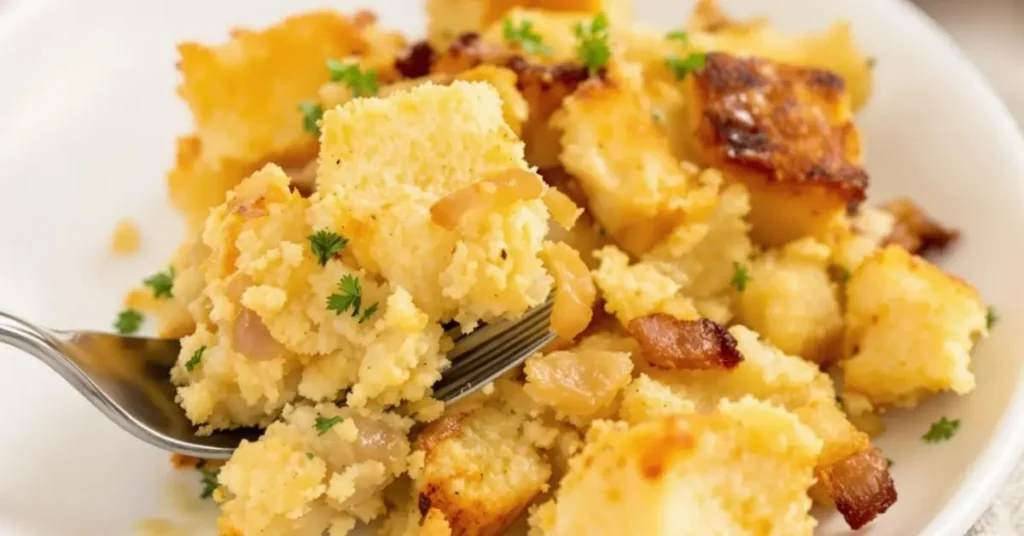
Our garlic bread stuffing recipe redefines the holiday feast by offering a unique twist on classic stuffing. This innovative dish blends crisp garlic bread with savory herbs to create a memorable alternative to traditional recipes. Elevate your Thanksgiving table by embracing this delightful fusion of flavors.
Discover a perfect holiday side dish that promises both comfort and excitement with this garlic bread stuffing recipe. Impress your guests with this innovative alternative and transform your meal into an unforgettable experience. Don’t hesitate—try this recipe today and add a burst of culinary creativity to your celebration.
Don’t miss out—follow us on social media for updates:


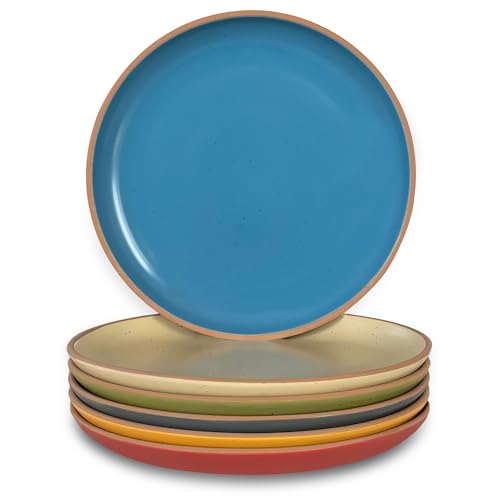




![Best Garlic Bread Stuffing Recipe for Thanksgiving 9 Soup Containers with Lids [48 Sets -32 oz.] Quart Plastic Deli Co...](https://m.media-amazon.com/images/I/51pUJidrMYL.jpg)
